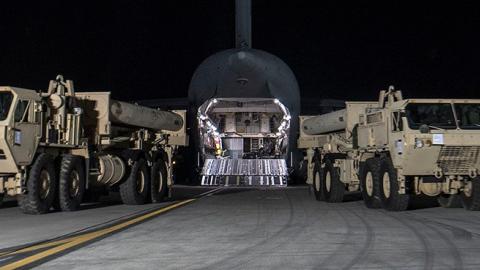Newly elected South Korean president Moon Jae-in made it official last week: His government will delay deployment of the US-built Terminal High-Altitude Area Defense anti-missile system (THAAD) for two years. THAAD remains South Korea’s only viable defense against a surprise missile attack by its rogue neighbor to the North. But China — which has expressed concerns that THAAD might be turned on to intercept its missiles if it decides to attack South Korea, and that the system’s highly advanced radar could be used to peer into PRC airspace — put the diplomatic and economic screws to the leftist Moon until he obligingly and predictably caved.
The excuse given is that the South Korean government needs to do an “environmental impact assessment” of THAAD. “We are not saying the two [THAAD] launchers and other equipment that have already been deployed should be withdrawn. But those that have yet to be deployed will have to wait,” an official with the presidential office told Korean media. No one expects that promise to be kept. Beijing will not be happy until every trace of THAAD is gone from South Korean soil and the rift that suspension of deployment has caused between Washington and Seoul is permanent.
What this means is that the one remaining option for effective ballistic-missile defense against the North Korean threat is now, and always has been, the plan I previewed here in late March a boost-phase-intercept system using unmanned aerial vehicles (UAVs) equipped with conventional interceptor missiles.
Anti-missile systems such as THAAD, AEGIS, and Patriot only shoot down a missile as it re-enters the atmosphere toward the end of its flight, narrowing the margin for error and increasing the chances of collateral damage. Destroying the missile in its earlier, “boost” phase, while it’s still struggling to escape the atmosphere, has the advantage of halting the missile during the slowest, hottest phase of its launch, when it can most easily be detected by infra-red sensors. It is also the best way to ensure that the fallout from the destroyed missile lands in North Korea or the Sea of Japan, rather than in a Japanese city (if Japan is the target) or a U.S. military base in the region (if our forces are the target).
Our Missile Defense Agency is currently working on a boost-phase-intercept system using unmanned aerial vehicles equipped with high-energy lasers — but that plan is years away, since the lasers it would need to succeed don’t yet exist. That said, a UAV stationed at an altitude of 50,000–55,000 feet, 350 miles outside North Korean air space, carrying infra-red sensors and a conventional high-speed interceptor missile of 500 lbs. would still have the range, firepower, and time needed to bring down even a large North Korean ICBM in its boost phase. The technology needed to build and deploy such a UAV already exists, and it carries the added advantage of placating Beijing, because it would be stationed too far away to track or shoot down missiles fired from China.
Kim Jong-Un’s missile program is getting increasingly dangerous, with ever-greater accuracy and longer range. Kim already has nuclear-capable missiles that could hit Japan, and experts agree that it’s only a matter of time before he develops the technology to hit the U.S. mainland. A BPI system could be deployed in two years (or less, in a pinch) and would protect both Japan and the United States from a rogue attack.
As for South Korea, the real threat from the North has always been the enormous arsenal of 15,000 artillery pieces it has aimed across the 38th parallel, which would reduce Seoul to rubble in the event of war. But that’s all the more reason why South Korea should support the deployment of a BPI system. Such a system would not protect South Korea itself in the event that a missile was fired at Seoul from outside North Korean airspace, but it could prevent a rogue launch on Japan or the U.S. with the potential to trigger a conflict that devastates the peninsula.

















